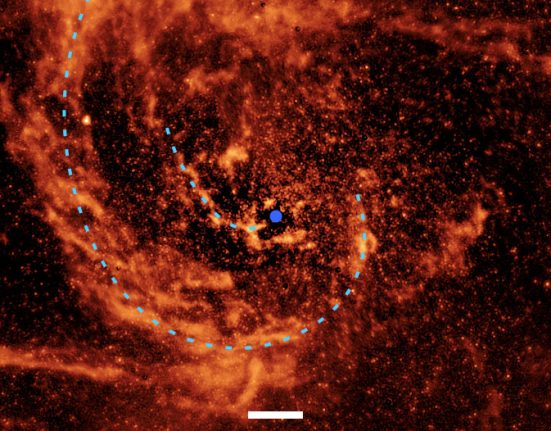
ESO / L. Calçada
An international team of astronomers has revealed a black hole that appears to have formed without the usual supernova explosion. By investigating exactly how this happened, they have helped cement a long-standing suspicion that this mechanism is responsible for the disappearance of a large number of stars.
When a massive star reaches the end of its life, it typically explodes in a cataclysmic display of celestial fireworks. These supernovae can be so bright that they temporarily equal the brightness of an entire galaxy; In a matter of seconds they can release as much energy as the Sun will release during its billion-year existence.
But do massive stars always detonate like this? No, according to a team of astronomers led by Alejandro Vigna-Gómez (Max Planck Institute for Astrophysics, Germany). His work focuses on a binary system in the Large Magellanic Cloud known as VFTS 243. “The system. . . It is remarkable,” says Vigna-Gómez. It consists of an ordinary star about 25 times more massive than the Sun, accompanied by a black hole that tips the scales at 10 solar masses. The team's findings are published in Physical examination letters.

Tamborra et al. / August 2014 Physical Review D
When a star dies in a supernova, material is usually ejected asymmetrically, causing a kick that sends the stellar remnant through space. Astronomers have seen many neutron stars boosted this way. However, the two objects in the VFTS 243 system remain in an almost perfectly circular orbit around each other. If the black hole experienced a kick when it formed, then it must have only been a small one.
Vigna-Gómez's team used this as an important constraint to help them model the formation of the black hole. “Combining advanced numerical models of stellar collapse with the principles of supernovae in binary star systems allowed us to obtain crucial information about the total collapse scenario,” says Vigna-Gómez.
The team's result points to neutrinos as an especially important factor. “It allowed us to conclude, for the first time, that neutrinos were emitted almost equally in all directions when the massive progenitor collapsed to form the black hole,” says team member Daniel Kresse (also from the Max Planck Institute for Astrophysics). Without a big asymmetry, without a big kick.
In fact, the team concludes that the original star lost only a small amount of mass (up to a third of that of the Sun) when its dense core collapsed. Instead of shedding its outer layers in a supernova, the collapse released energy primarily through a symmetrical ejection of neutrinos. The resulting kick to the newly formed black hole was only 4 kilometers per second.
By contrast, the shakes observed in newborn neutron stars (also formed through core-collapse supernovae) are typically hundreds of kilometers per second, with some even exceeding 1,000 kilometers per second. According to Vigna-Gómez, the VFTS 243 result demonstrates that massive black holes can form without a supernova explosion.
“The case . . . seems pretty compelling,” says Christopher Kochanek (Ohio State University), who was not involved in the research. However, Kochanek points out a possible alternative: if the two objects began in an elliptical orbit before an explosion of supernova, there could have been a significant asymmetric mass loss, with the resulting kick pushing them into a circular orbit.
Although it is not yet a clear-cut case, the direct collapse of black holes could help solve a long-standing astronomical mystery. Previous efforts such as Project of sources that disappear and appear during a century of observations (VASCO) have identified 100 stars that suddenly disappeared from the night sky over the past 70 years. If these stars collapsed directly into black holes, without supernova displays, that could explain their sudden disappearing act. If, unlike VFTS 243, they are not in a binary system, then such fully collapsing black holes would be considerably harder to find.








Leave feedback about this